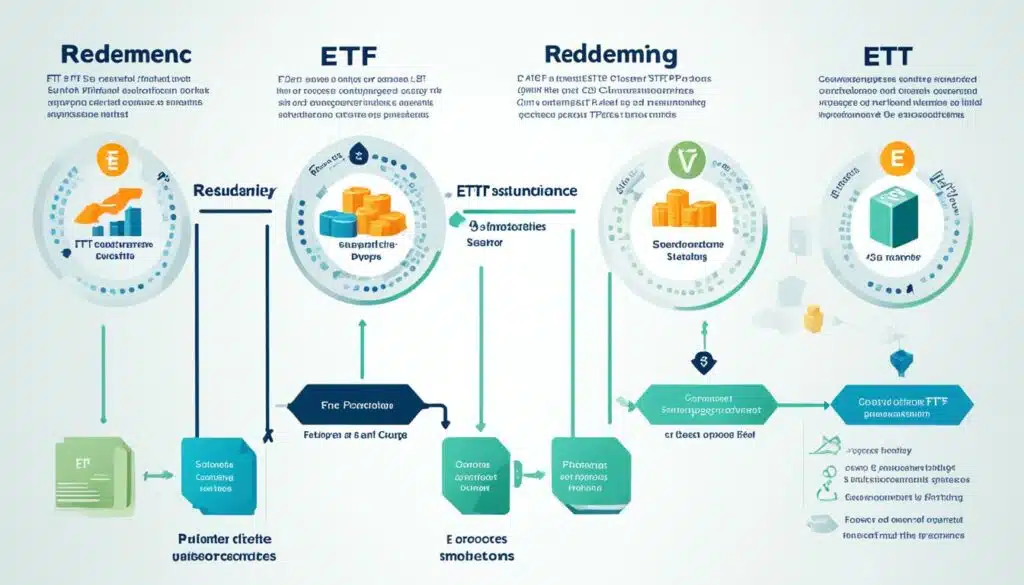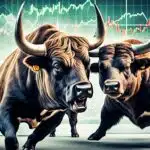The first exchange-traded fund (ETF) started in the U.S. in 1993. Since then, they have become very popular with people who invest and financial advisors. Although managed etfs are a growing investment option in the U.S., they’re still just a small part of the $8.12 trillion held in mutual funds. Yet, in 2018, assets in U.S. ETFs increased by almost 50%, hitting about $240 billion.
ETFs are like index-tracking actively managed mutual funds but are bought and sold on the stock market. They follow the performance of a specific index. These indexes can be large like the S&P 500, or focused on sectors, regions, countries, or investment styles.
Key Takeaways
- Exchange traded funds (ETFs) are investment funds that trade on stock exchanges like stocks.
- ETFs offer diversification and lower costs compared to traditional mutual funds.
- ETFs provide investors with the ability to trade throughout the day, unlike mutual funds which are priced at the end of the trading day.
- The ETF market has experienced rapid growth, with assets under management reaching over $240 billion in the U.S. in 2018.
- ETFs offer exposure to a wide range of asset classes, including stocks, bonds, commodities, and currencies.
What are Exchange Traded Funds?
Exchange traded funds (ETFs) are like stocks but are investment funds. They are similar to index mutual funds because they follow a specific index or sector. But, ETFs are different from mutual funds in ways that make them a great choice for investors.
Definition and Key Features of ETFs
ETFs work by joining the money of several investors. This money is used to buy a variety of securities like stocks or bonds. The fund then trades on a stock exchange. It aims to copy the index or sector it’s linked to, offering a way to invest in a bunch of assets through one purchase. Since ETFs are usually not actively managed, they tend to follow their index closely.
Similarities and Differences Between ETFs and Mutual Funds
ETFs and mutual funds both gather money from many different people to invest. But they work in distinct ways:
| Feature | ETFs | Mutual Funds |
|---|---|---|
| Trading | ETFs are traded like stocks and their prices change all day on the market. | Mutual funds are priced only once each day, at the market’s close, based on the fund’s net asset value (NAV). |
| Costs | ETFs usually cost less because they have smaller management fees and operation expenses. | Mutual funds might be more expensive because they are actively managed, which can lead to higher costs. |
| Tax Efficiency | ETFs tend to be better for taxes since they make fewer capital gains distributions than mutual funds. | Mutual funds might have higher taxes because they trade their assets more frequently. |
| Transparency | ETFs are clear about what they hold and how much they are worth every day. | Mutual funds can be less clear about what they own and their daily value. |
These differences can impact how investors choose between ETFs and mutual funds. They affect tax management and expenses.
The Rise of Exchange Traded Funds

Exchange traded funds, or ETFs, have become very popular in the last 20 years. The assets under management (AUM) in ETFs have grown a lot. This shows more and more people like to use them.
Growth of ETF Assets Over the Years
By the end of 2022, ETF assets in the U.S. reached $7.76 trillion. This was up from $82 billion in 2000. It shows a huge increase in people wanting to use exchange traded funds.
Reasons Behind the Increasing Popularity of ETFs
There are a few reasons why exchange traded funds are so popular. First, they cost less than traditional mutual funds. Second, you can buy and sell them quickly, much like individual stocks. This makes it easy for people to use them. They also offer a big view of the market and spread out risk through diversification.
There are also many different ETFs to choose from. This means people can pick the ones that fit their style of investing. These options are good for people with different amounts of risk they are willing to take. ETFs are exchange-traded investment funds that offer investors the flexibility to buy and sell shares throughout the trading day on stock exchanges.
The use of ETFs has grown among professionals and regular investors. It’s not just for Wall Street anymore. New companies and products keep coming, making the ETF world bigger. Because of this, ETFs will probably keep being popular in the future.
Benefits of Investing in Exchange Traded Funds

Exchange traded funds (ETFs) shine bright for both new and seasoned investors. They offer several key benefits. These make them a solid investment choice. Some top advantages of investing in ETFs are:
Low Costs and Expenses
ETFs usually have lower expense ratios than traditional mutual funds. They come with less management fees and trading costs. Plus, they have lower administration expenses. All this can mean more money for investors in the end. This is especially great news for those aiming for long-term portfolio growth.
Diversification and Asset Allocation Opportunities
With ETFs, investors can spread their investments across many asset classes. This includes several sectors and investment styles. ETFs follow specific indexes. They offer a mix of basket of securities. This can help reduce risk and meet investors’ asset allocation goals. An ETF that tracks a stock provides investors with a convenient way to gain exposure to the performance of a specific company within a diversified investment vehicle.
Liquidity and Real-Time Trading
ETFs are like stocks and are traded on exchanges. This means investors can buy and sell them anytime the markets are open. This flexibility in trading and the chance for real-time transactions give investors more power and freedom with their investments.
Types of Exchange Traded Funds

The exchange traded funds (ETF) world has grown big. Now, investors have many choices. They can pick from a variety of asset classes and investment strategies. Key types of ETFs include:
Equity ETFs
Equity ETFs copy the movements of stock indexes, sectors, or stocks. They let people invest in equities. This can be for overall market activities or for specific investment styles. For instance, you can choose growth, value, or dividends. Known examples are S&P 500 ETFs, sector ETFs, and thematic ETFs.
Fixed Income and Bond ETFs
Fixed income ETFs and bond ETFs give a mix of fixed-income securities. These include government bonds, corporate bonds, and others. Investors use them to handle interest rate risk and to earn money from their investments.
Commodity and Currency ETFs
Commodity ETFs and currency ETFs offer chances to invest in things like gold, silver, and foreign currencies. These ETFs are good for diversification, inflation hedging, and for those looking to speculate. Examples are gold ETFs, oil ETFs, and USD/EUR ETFs.
| Type of ETF | Description | Examples |
|---|---|---|
| Equity ETFs | Track stock indexes, sectors, or individual stocks | S&P 500 ETFs, sector ETFs, thematic ETFs |
| Fixed Income and Bond ETFs | Invest in a diversified portfolio of fixed-income securities | Government bond ETFs, corporate bond ETFs, high-yield bond ETFs |
| Commodity and Currency ETFs | Provide exposure to commodities and foreign currencies | Gold ETFs, oil ETFs, USD/EUR ETFs |
How ETFs Work: Creation and Redemption Process

The creation and redemption process of exchange traded funds (ETFs) is unique. It helps ensure that ETF prices match the net asset value (NAV) of the underlying securities. This is done with the help of authorized participants (APs). They are essential for keeping the ETF market in order. The exchange-traded fund comprises a diversified portfolio of various assets, with shares in that fund representing proportional ownership of the underlying securities.
The Role of Authorized Participants
Authorized participants, or APs, are key players. They are usually large financial companies, known as broker-dealers. They work with the ETF sponsor to make or take back ETF shares.
APs trade a basket of securities linked to the ETF’s portfolio for new ETF shares, or they can return ETF shares for the actual securities. This process makes sure the ETF price doesn’t wander far from the NAV of the fund’s assets.
Also read : Accidents Happen: 5 Reasons Why You Need Accident Insurance Worth It Now
Keeping ETF Prices Aligned with Net Asset Values
Authorized participants (APs) are crucial for managing ETF prices. They operate the creation and redemption process to maintain the ETF’s price close to the net asset value. If the ETF price doesn’t match correctly, APs can fix it.
For instance, if the ETF’s price is higher than its NAV, APs can step in. They create new ETF shares using the securities they hold. This adds more ETF shares and lowers the price. If the ETF price is lower than the NAV, they buy back ETF shares. This reduces shares available and increases the price to meet the NAV again. The Securities and Exchange Commission oversees and regulates the securities industry to protect investors, maintain fair and efficient markets, and facilitate capital formation.
This way of creating and redeeming ETF shares, with APs in the middle, is critical to how ETFs work. It’s a process that makes ETFs different from regular open-ended funds. By managing the ETF market like this, it stays efficient and liquid. More on ETFs.
Exchange Traded Funds vs. Exchange Traded Notes
Exchange traded funds (ETFs) and exchange traded notes (ETNs) seem like the same thing, but they’re different types of investments. ETFs are like baskets of securities that you can buy or sell on stock exchanges. On the other hand, ETNs are like IOUs from financial firms. They follow the performance of a certain asset or index. Diversification benefits of mutual funds are evident in their ability to spread investments across various asset classes, minimizing the impact of market fluctuations on the overall portfolio.
One big difference is how they work and the risks involved. ETFs are pretty straightforward. They own the securities they say they do. But ETNs are a bit riskier because they’re basically loans from a financial firm. This means you are trusting that firm to pay back your investment. Also, ETFs can be better for taxes. They might not have as many capital gains taxes as ETNs do.
So, when choosing between ETFs and ETNs, you need to look at what you’re investing for and how much risk you’re okay with. Think about what you want your investments to do for you and how they fit into your overall financial plan.
FAQs
Q: What is an exchange-traded fund?
A: An exchange-traded fund (ETF) is a type of investment fund and exchange-traded product that holds assets like stocks, commodities, or bonds.
Q: How does an ETF differ from a stock?
A: While a stock represents ownership in a single company, an ETF is a collection of different assets, providing diversification benefits.
Q: What is the meaning of ETF?
A: ETF stands for exchange-traded fund, a type of investment fund traded on stock exchanges.
Q: How does an ETF track an index?
A: An ETF may track the performance of a specific index by holding the same securities in the same proportions as the index.
Q: What is an expense ratio in relation to ETFs?
A: The expense ratio of an ETF is the annual fee charged by the fund provider to cover operating expenses.
Q: How can I invest in an ETF?
A: You can invest in ETFs through a brokerage account, where you can buy and sell shares of the ETF like individual stocks throughout the trading day.
Q: What are the benefits of investing in ETFs compared to mutual funds?
A: ETFs typically have lower fees than mutual funds and offer greater flexibility in trading, as they are traded on exchanges like stocks.





